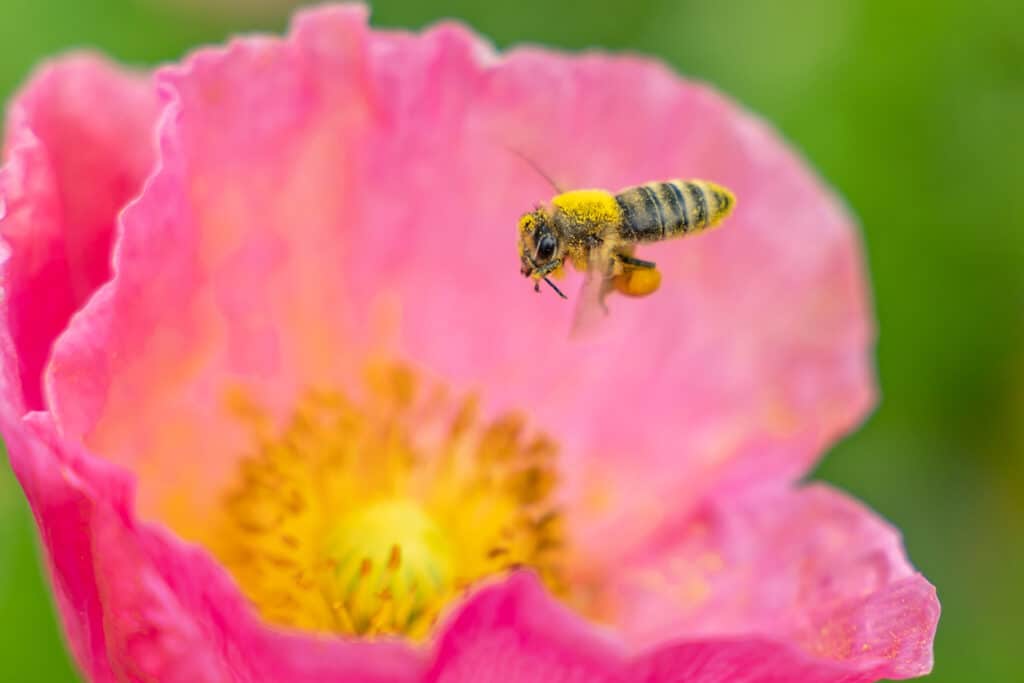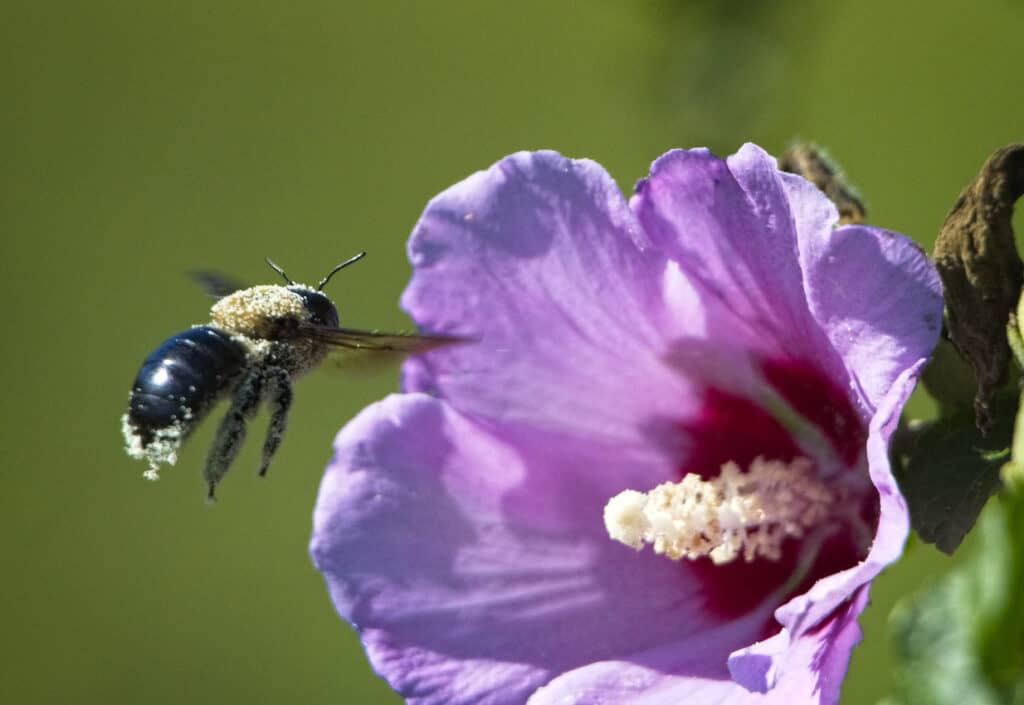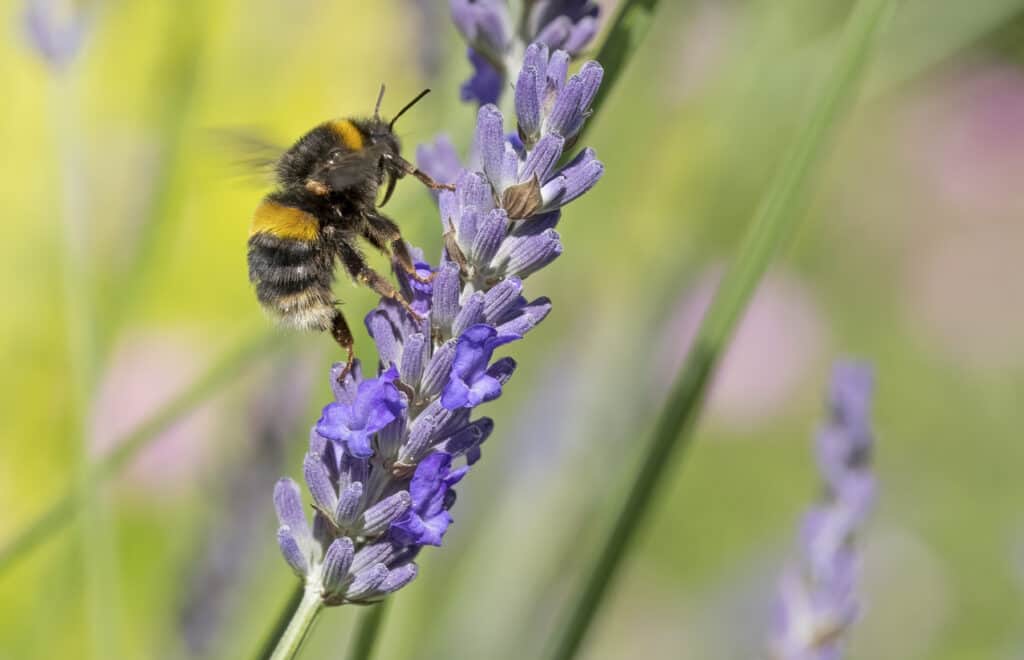It’s quite a question and one that is hard to get serious about! But the more one thinks about it, and the more one looks at the origins of the phrase “the bees’ knees,” the more interesting it becomes. It’s not a new expression, and it’s a phrase rich in meaning and history.
Bees’ legs have six sections, each one connected by a joint. So, bees not only have knees, they have many! The most knee-like joint is between the bee’s femur and the tibia. If you think there’s no such thing as bees’ knees, think again. And there’s more to the expression than the literal meaning.
Now that we’ve established that bees have leg joints and leg joints are referred to as knees, we have a definitive answer that bees have knees. They may not be that useful, as a bee still cannot kneel, but that’s only part of the story – how did the expression arise, what does it really mean, and are bees’ knees associated in any way with a fly’s thighs?
Where Are The Knees On A Bee?

A bee, like all insects, has three pairs of legs, so a total of six. As mentioned, each leg is made up of six segments connected by joints.
- The coxa is a small segment that connects the top of each leg to the thorax or body of the bee, with the front pair pointing forward, the center pair slightly backward, and the rear pair pointing backward. So, this joint could be considered a shoulder or hip joint rather than a knee.
- The trochanter is a tiny segment between the coxa and the femur, allowing upward and downward movement of each leg. The joints here are a sort of a knee in how they function.
- The femur is connected to the trochanter by a diagonal joint so that both segments move as one – not a knee in the true sense of the word.
- The tibia is the fourth segment, joining the femur and metatarsus, and this is considered to be the bee’s knee.
- The metatarsus connects the tibia and the tarsus. It contains a tendon rather than muscle, so it can be compared to a heel or ankle.
- Lastly, the tarsus, which is the bee’s foot, contains three tarsi and a pre-tarsus or claw.
So, we can confirm that the bee has at least six definite knees and another twelve joints which perform some of the functions associated with the knee. They may be small, but they work!
Does A Bee Need Knees?

While all six legs are used for walking, the front and rear legs also have additional functions, and the bees’ knees have an essential role to play.
- The front pair is also used for grooming the antennae and for moving the pollen from the flower to the rear end of the bee. The bee’s knees help to rotate the legs to perform these maneuvers.
- The bee covers itself in pollen, and then worker bees’ rear legs are used to accumulate the pollen in sacs or pockets called corbicula, where it is mixed with nectar to prevent it from falling when the bee travels back to the hive. There’s a connection here to the meaning of “bee’s knees,” which we’ll discuss later.
- Amazingly, the pre-tarsus or claw is also used to taste the pollen to ensure that it is ready for collection.
So the bee’s legs, with their six segments, their joints, and their knees, are perfectly designed to perform the tasks of collecting, accumulating, and transporting the pollen. They allow the bee to move in any direction, climb any surface, and, to use the idiom correctly, are quite the bee’s knees.
Origin And Meaning Of The Expression The Bee’s Knees

As with so many expressions in the English language, there are several theories and opinions regarding the first time “the bee’s knees” was used either verbally in conversation or in the written form.
“The bee’s knees” is termed an idiom, which is defined as a group of words with an obscure meaning that is not clear from the individual words themselves. Idioms are figures of speech particular to a specific language that reflect a sentiment but are not intended to be taken literally.
The Early Verbal Use Of Bees Knees Is Difficult to Prove
- It has been suggested that the expression is a corruption of “the business,” meaning something of quality and status (“that house is quite the business”). “The business” is a commonly used expression in England rather than in the US. There is the suggestion that Italian immigrants to the United States confused “business” and “bee’s knees” and, in this way, introduced the expression. However, there is no clear evidence available that supports this theory.
- Another unproven suggestion is that the phrase is based on the fact that the sacs which are found on bees’ legs are used to carry pollen back to the hive for the production of honey. Honey is, in turn, synonymous with sweetness, excellence, and goodness. And so the legs, and by association, the knees, are therefore associated with the best life has to offer. While this is an interesting theory, it does seem a little farfetched.
Eighteenth-Century Use Of The Bee’s Knees
In the late eighteenth century, a similar expression was used but denoted something different from the current meaning of the idiom.
- Rather than pertaining to excellence and desirability, it described something as being not as big “as a bee’s knee” and therefore small and insignificant.
- Also, at this time, the phrase was used to describe something that didn’t exist at all. For example, a naïve servant would be sent on a fool’s errand to fetch a bucket of bee’s knees for his master, maybe together with other impossible items like striped paint or hens’ teeth.
Although these meanings persisted into the twentieth century, they have become obsolete, and today they no longer form part of the accepted use of the idiom “the bee’s knees.”
Use Of The Bee’s Knees In Twentieth-Century United States
It seems that the use of the phrase “the bee’s knees” began in the United States early in the twentieth century. Since that time, it has survived in daily conversation and is now a well-accepted and commonly used expression.
Changes in meaning are evident in cartoons and comic writings of the day.
- The use of “bee’s knees” in the United States initially followed the older English usage so that it applied to small, insignificant things or those that didn’t exist in real life, even if they sounded like they should. Mention is made in humorous articles written at the time of people eating bees’ knees and sewing buttons on ice cream.
- The 1920s were famously termed the Roaring Twenties, and after the death and destruction of World War One, there was a huge appetite for innovation, wealth, and luxury.
- Radio, music halls, dancing, and illegal booze were the order of the day. It was the era of the Charleston, flappers, and it became fashionable to embellish one’s conversation with catchy phrases. “The bee’s knees” was one of them.
- Other similar idioms, such as “the monkey’s eyebrows” and “the kipper’s knickers,” have failed the test of time. Phrases that had the same meaning and a similar ring to them included “the flea’s eyebrows” and “the canary’s tusks.”
- All were equally imaginative and improbable but only “the bee’s knees” and “the cat’s whiskers” survived and are still accepted idioms.
- One of the less plausible theories for the origin of “bee’s knees” links the expression to Bee Jackson, who was a well-known dancer in the 1920s, famous for her energetic Charleston routines and her very active knees.
Modern Use Of The Bee’s Knees
In today’s global village, English is widely used as the lingua franca and is spoken by billions of people around the world as a first or second language. As a result, the meaning of the expression “the bee’s knees” has become universal, and it now means one thing – excellent. So, it can refer to a person – “As a designer, he really is the bee’s knees” or it can refer to the quality and desirability of an object – “The new Cadillac CT 5 is, in my opinion, the bee’s knees”.
A Few Synonyms For The Bee’s Knees
To clarify the meaning of “the bee’s knees,” Merriam-Webster’s Dictionary gives some modern-day equivalents:
- The cat’s meow
- crackerjack
- doozy
- humdinger
- knockout
And Then There’s A Totally Different Meaning
We’ve examined in detail the source and origins of the idiom “the bee’s knees” and established that having once implied a non-existent object and then a lack of size and significance, it now means the exact opposite, the epitome of excellence. But it has a totally different meaning, too, and that is as the name given to a cocktail.
Who Was The Inventor Of Bees Knees Cocktail?
The Bees Knees is a popular cocktail that history tells us was invented during the Prohibition era in the US. Its main ingredients are gin, fresh lemon juice, and honey. Some say it was invented in 1921 by an Austrian bartender named Frank Meier, who was Head Barman at The Ritz in Paris.
Other history buffs have suggested a more romantic origin, that it was invented by the famous Unsinkable Molly Brown. Margaret Brown (her real name) was a wealthy American socialite and philanthropist, the widow of a gold miner, who derived her nickname posthumously, and became the subject of a movie, by surviving the sinking of the Titanic.
She lived part of the year in Denver, and the remainder in Paris, where she frequented the recently introduced women-only bars. It was here, according to legend, that she invented the “Bees Knees” cocktail.
Origin Of The Bees Knees Cocktail
An interesting fact about the cocktail is that it was created as a way of masking the rather bitter taste of “bathtub” gin, which got its name because it was made illegally during Prohibition. Because it achieved its purpose so well, the name was considered totally apt.
However, like the idiom, there’s some confusion about exactly what the cocktail is. The International Bartenders Association (IBA) rules that it should be served straight up, without ice, in a cocktail glass. Other recipes call for it to be served chilled with a sprig of basil or thyme.
The IBA also, in their specified ingredients, allows for the dilution of lemon juice, and for the honey to be mixed with syrup. So, like the idiom, the drink has meant different things to different people.
Official Recipe For The Bees Knees Cocktail
The IBA has provided the recipe that all members should use in preparing The Bees Knees.
There are different versions of this recipe, but the basics are common to all – gin, honey syrup, lemon juice, and garnish.
Ingredients For Bees Knees Cocktail
2 ounces gin of your choice
3/4 ounce freshly squeezed lemon juice
1/2-ounce honey syrup (50% diluted with water or orange juice}
Garnish: Twist of lemon, or alternatively a sprig of basil or thyme can be used
Method
Combine the gin, honey and lemon in a cocktail shaker
Add ice (optional) and shake well.
Strain into a chilled cocktail glass.
And here’s a quick video guide;
Conclusion
The question of whether bees have knees is easily answered – they certainly do. As part of the amazing mechanism that is the leg of the bee, the knee is small, as inferred by the early meaning of “a bee’s knees,” but by no means insignificant. If one thinks about how vital the role of bees is in pollinating the plants we live on, that knee takes on a whole new level of importance.
As far as the idiom itself is concerned, the term “bee’s knees” has evolved from the eighteenth century to the present. Its meaning has changed completely, from implying non-existence to small and insignificant, and finally to excellence and perfection. And then, there’s the cocktail!
References
https://idioms.thefreedictionary.com/the+bees+knees
https://www.phrases.org.uk/meanings/the-bees-knees.html
https://www.urbandictionary.com/define.php?term=the bee’s knees

